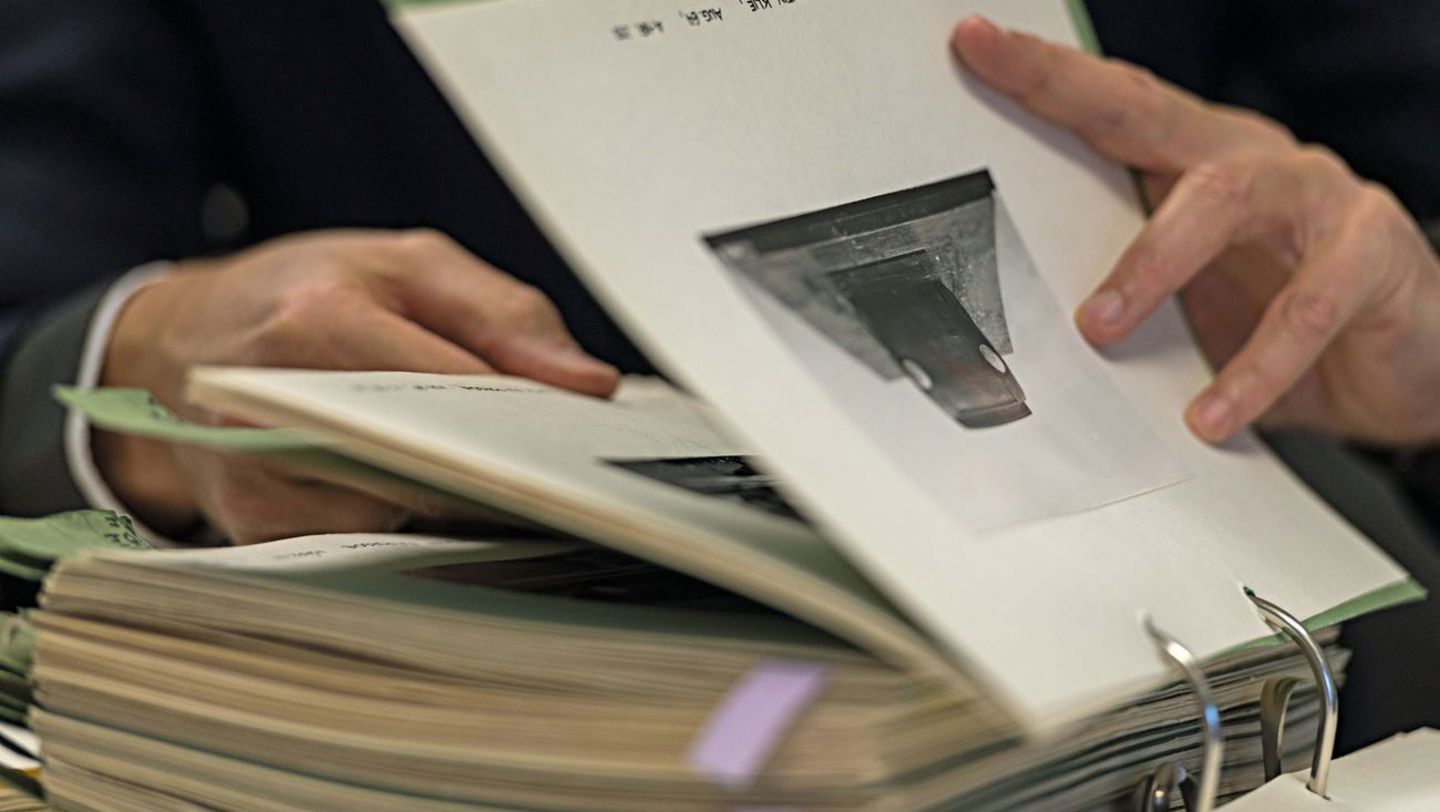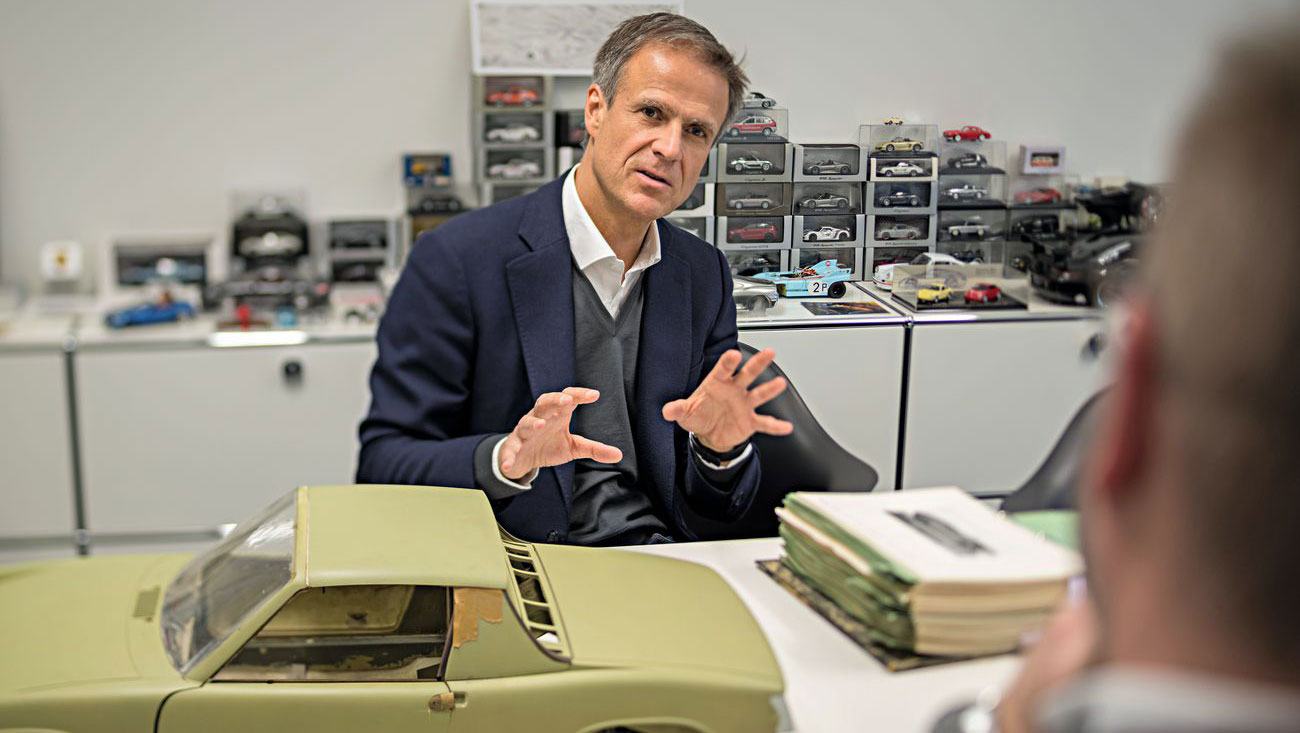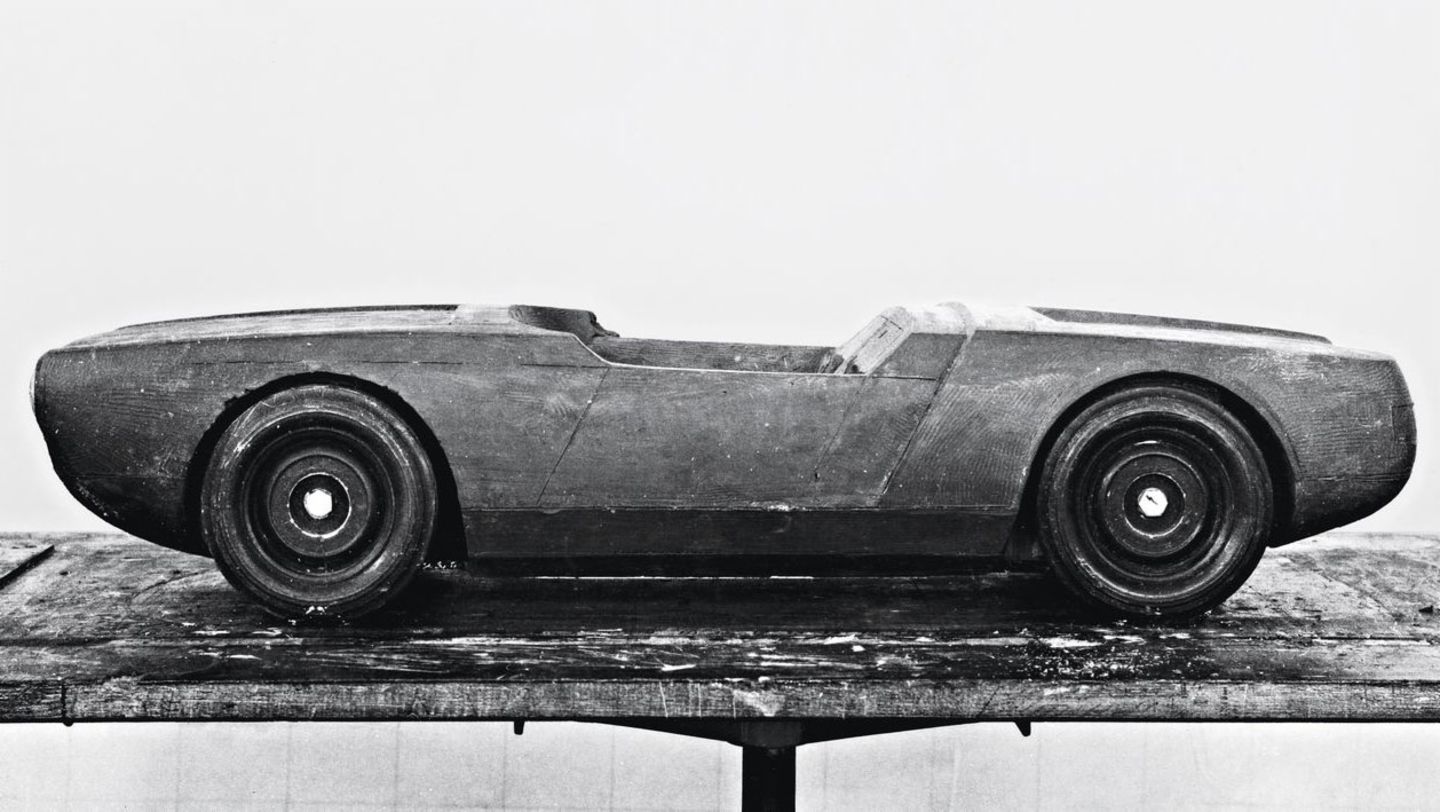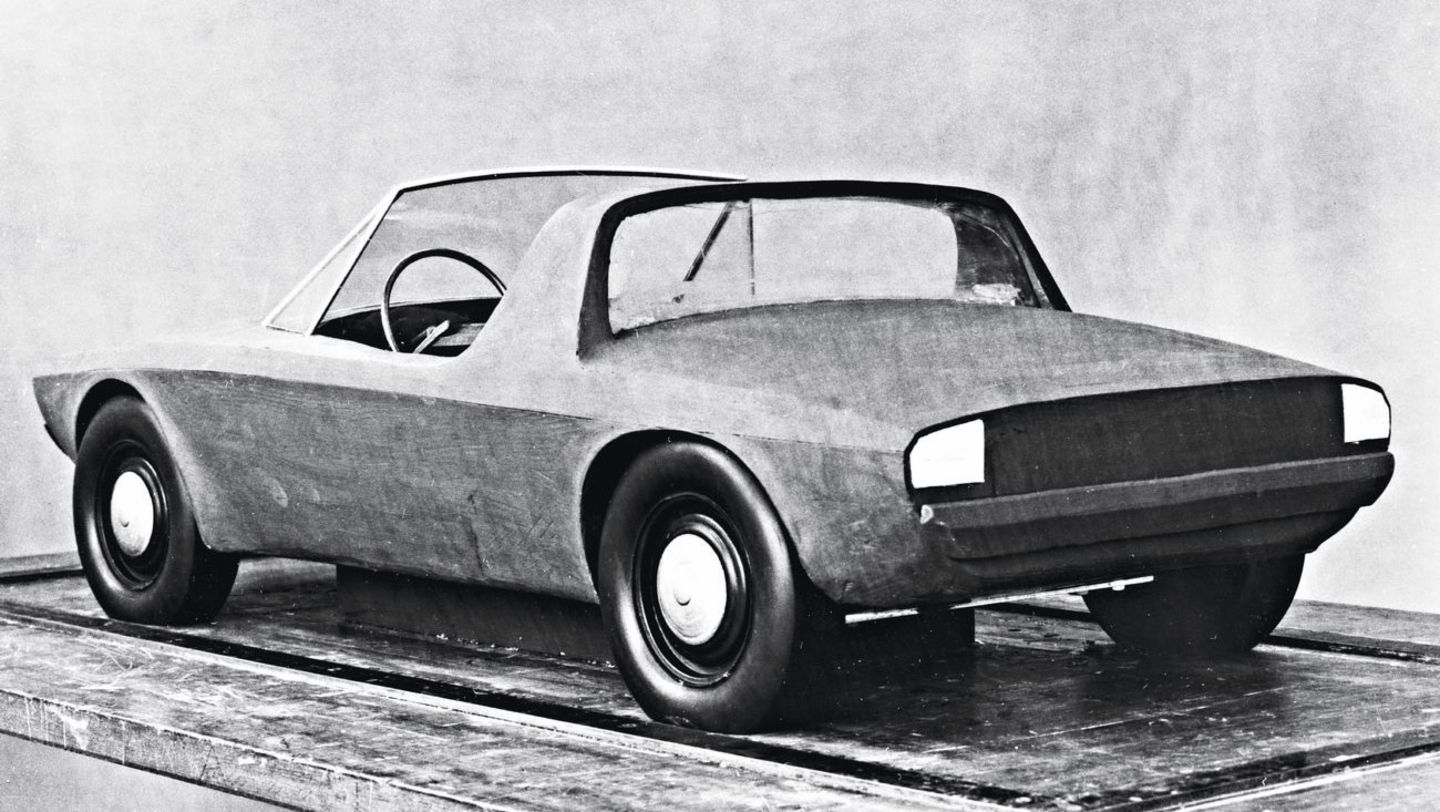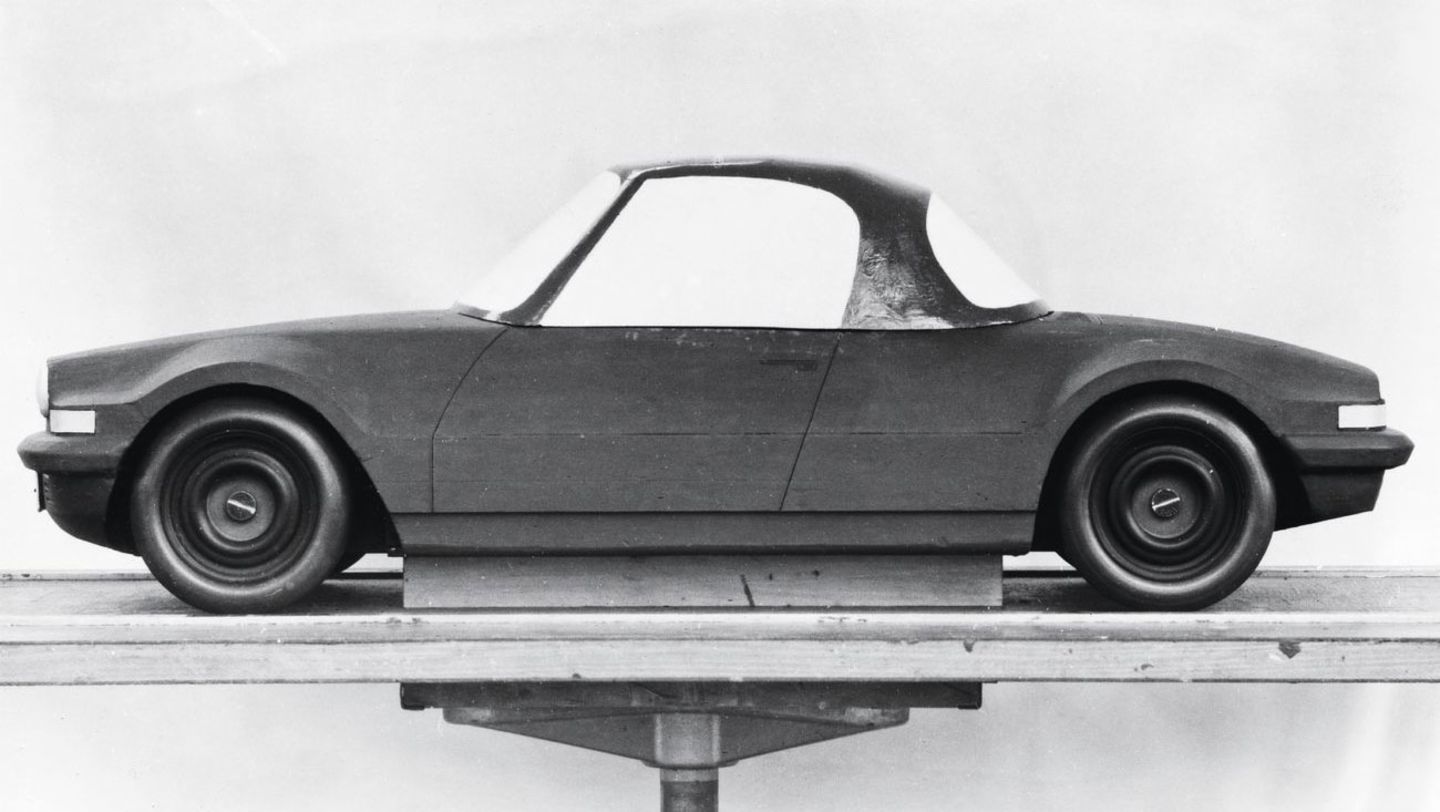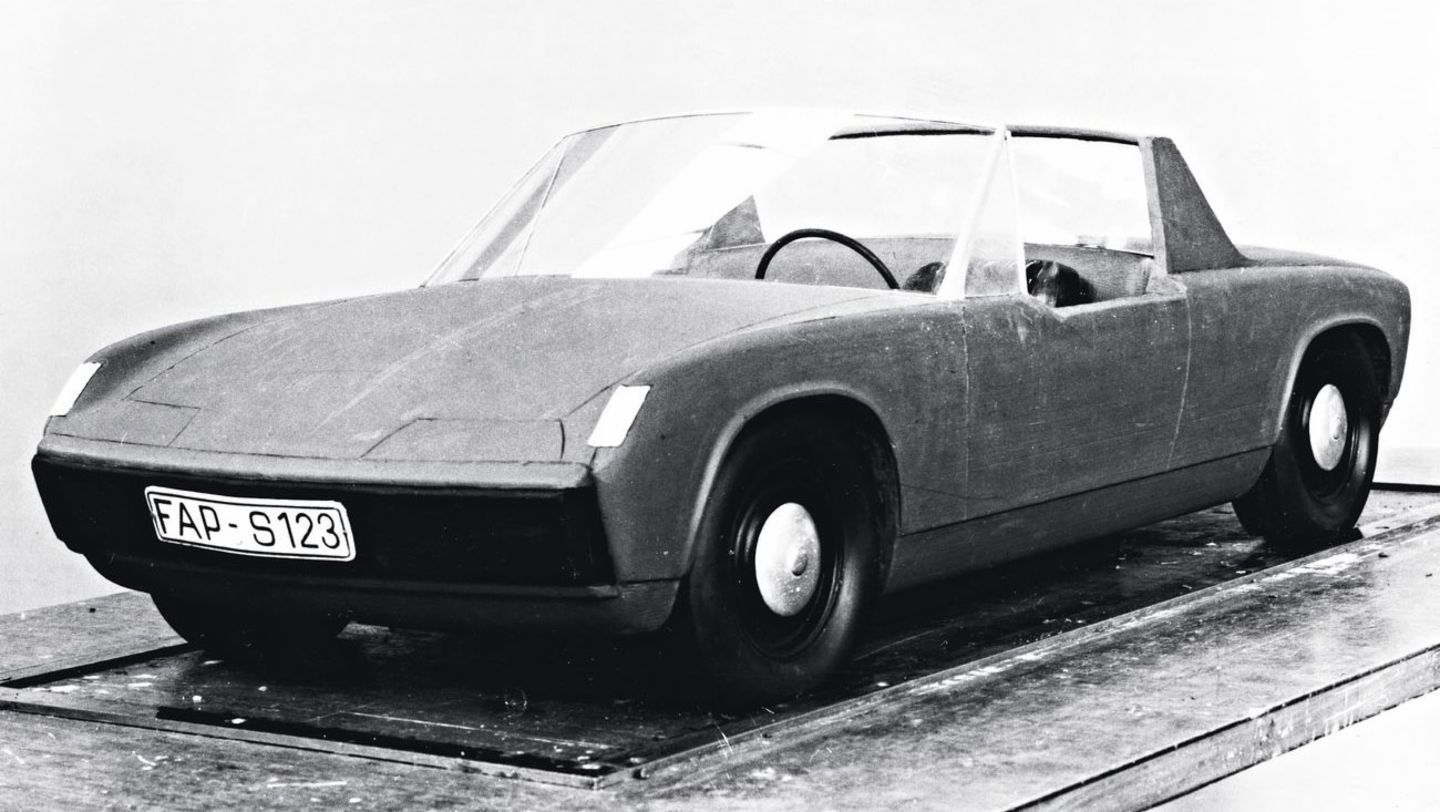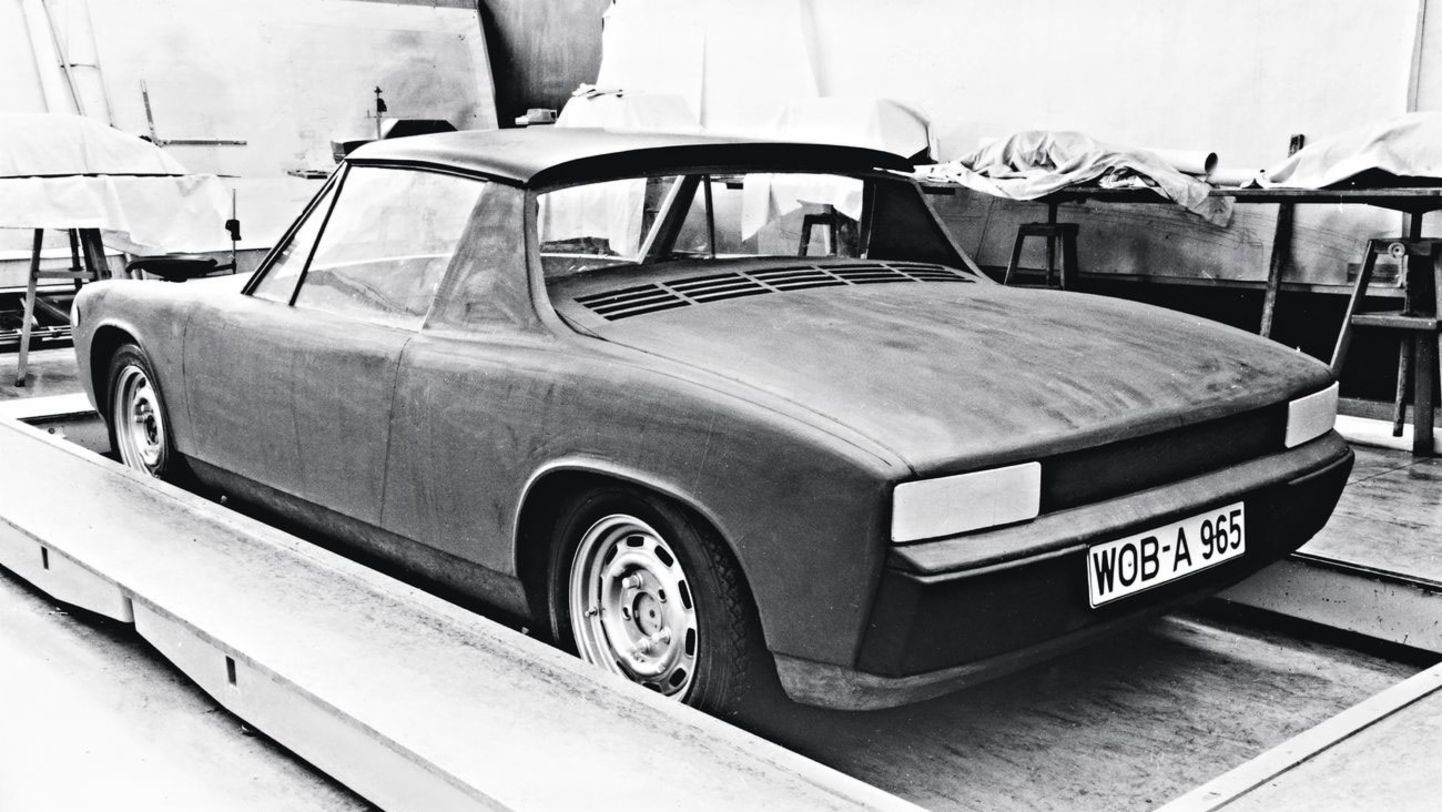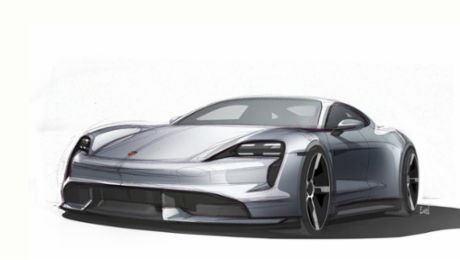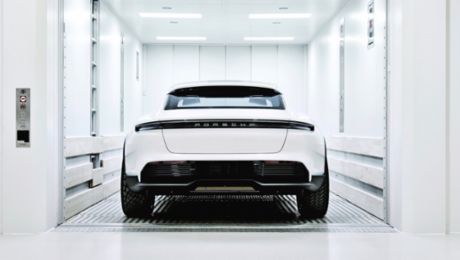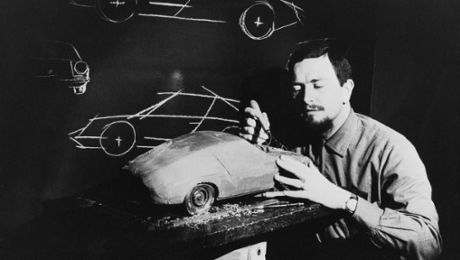The idea came from Porsche. Ferry Porsche wanted an entry-level Porsche that would give young drivers inexpensive access to the world of Porsche. This alone makes the 914 a typical Porsche. Because he was trying something new. Because the heart of the car, the engine, is mid-mounted. And because the form follows the function. The 914 is typically Porsche, even though it doesn’t look like it at first glance. But the first known design draft quotes a Porsche that could hardly be more typical and steeped in history – the 550 Spyder.
Ferdinand Alexander Porsche and his team were responsible for the design of the 914. The final design implemented for the series was developed by Heinrich Klie, one of his most important staff members. A man trusted by Ferry Porsche’s eldest son when he took over responsibility for design at his father’s company. Although the actual start of development dates back to August 1966, the Porsche AG Historical Archive contains older drafts, titled: “914, Model 1, August 1964, design: Klie”. He describes the development of the car throughout its lifetime as an iterative process in which the management largely gave the designers free rein. Changes were only discussed after the presentations of the 1:5 scale models. For Ferdinand Alexander Porsche, the way forward was clear: “The 914 was always a completely independent design which was also a formal success.”
Michael Mauer has been responsible for Porsche design since 2004, making him only the third Head of Design after Ferdinand Alexander Porsche. Here, he talks about the proximity of the first draft to the 550 Spyder role model, the design process then and now, and the development of the Porsche brand identity.
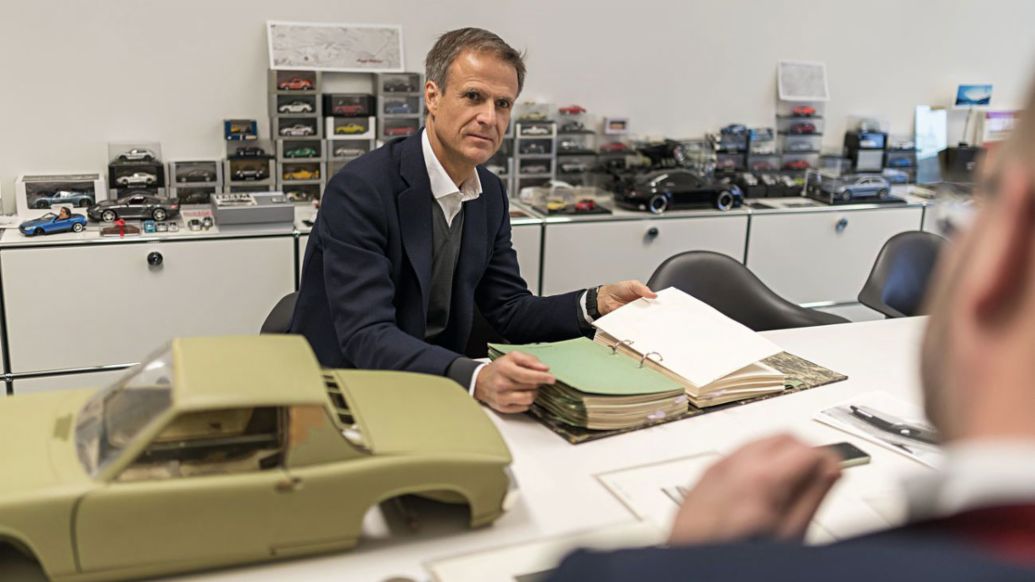
Michael Mauer: The influence of the 550 Spyder is clear in the Model 1 dating back to 1964. I immediately wondered about the specifications, the basic orientation. For an entry-level Porsche, the 912 concept – a four-cylinder 911 – could have been developed further. So why did they go back to the mid-engined concept? The inspiration of the 550 is obvious. As a designer, I understand this. Because the car was also the smallest of the choices, the most agile. Minimalist, puristic. Using this as a starting point, as a beginning for development of a new model, as inspiration, is logical.
From the 550 concept to the 914. An evolution that resulted in a new, independent model in 1969?
For me, on closer inspection, this isn’t even so much a formal evolution. The models make it clear that the 914 actually had no real predecessor. The various drafts, some of which are very different, literally show the search for a concept around the theme of the 550. This was high-tech in its day, certainly a real racing car. The idea of building a small mid-engined car again came naturally. That’s how you orient yourself.
The first draft in 1964 was followed by the Model 2, which went in a completely different direction. It was actually a lot more elegant, a lot less sporty. This reminds me of many things, but not necessarily of the “small, sporty, puristic” theme. This – in my opinion – relatively strong difference shows that the search was open-ended at the time. With the five models from 1964 to 1967, the design process of the 914 shows exactly this search for a new series alongside the 911. The basic package was established, but the formal characteristics were still enormously different initially. In chronological order, we started with “something like the 550”, then the discussion obviously headed in a different direction.
“Brand identity comes about by following functionalities.” Michael Mauer, Head of Style Porsche
From the successor to the 550 for the 1970s to a draft that actually looks quite different?
Quite different! This is already apparent in the second draft, which I find sensational. This one looks almost American-inspired. The fourth model isn’t really modern at all, and then we come to this one (note: the Model 5, Klie). The back in particular is very modern for that time and the point in the sequence. It looks clean, neat. That fits the bill. That’s why I’m surprised that the May 1966 draft (note: the Model 2) was also created by F. A. Porsche, because it doesn’t really fit with his design philosophy. If we look at the first model from 1964 and compare it with the development two years later, it doesn’t have the characteristics or appeal of the basic 550 concept at all. The result is comparable with the development from the 356 to the 911. That was an incredibly courageous step back then – the new model had that modern factor. The 914 Model 3 is just starting to get precisely that modern factor. Even if you look at these front lines, these clear surfaces. Good proportions. The July 1966 draft is quite different, and more suitable for the Model 2. Two competing drafts which were then discussed. At that time, in my opinion, they made absolutely the right decision and went for the much more modern design.
The first drafts are clearly different, then one builds on the other, and the others are created by two different designers at the same time.
Designers who ultimately end up working on the same project talk to one another. To compare it with what we’re doing today, this phase is similar to the development of the Panamera. At that time, we knew what we wanted, the concept was there, and we basically came up with two variants. One like this, the other like that. And as you can see from the 914 models, people work side by side. They inspire one another, they influence one another in their work. You end up looking across the room, and thinking yeah, I like that. And you incorporate it.
The 914 of 1969 is a real mid-engined Porsche. Even though it looks very different to the 911. Are elements such as the Targa bar a way of formally demonstrating a common family bond?
A mid-engined sports car is indeed a typically Porsche thing. At the time of the Auto Union, the competition still began with a front-mounted engine, and Porsche developed the first mid-engined racing cars. The 356 “No.1” Roadster is a mid-engined car, too. This had to be changed in favour of mass production capability. Given this background, Ferry Porsche’s idea is understandable – okay, let’s make another of those robust entry-level models. The mid-engine is the right concept for things like that. The Targa was created as a solution for the safety issues and the new regulations from the US. Actually, a minimal roof is really all you can have with an open, reduced, minimalist concept familiar from the 550, or perhaps the Speedster as well. But if the new legislation no longer allowed this, the way forward was clear for the 914. We ourselves had already come up with a good solution for combining top-down driving and safety – the Targa bar. After all, the concept was to combine the idea of “top-down” and “safety”, and now we had to make it modern! The final design is characteristic of the styling philosophy under the direction of Ferdinand Alexander Porsche. This common ground almost automatically led to the creation of a brand identity. Although that certainly wasn’t the actual intention.
Does the concept set the course for the design?
That’s how I see Porsche to this very day. First, we ask ourselves – what would be the best concept? Entry-level, reduced, sporty. When it comes down to it, what do I really need if I’m going to have fun driving? A mid-engined car, obviously. And then transferring the formal characteristics is a logical next step. To create a car with particularly attractive proportions on account of the engine position. The 914 has typical mid-engine proportions, that has to be said. I don’t know whether there was anything comparable, especially not in those days.
A question about the schedule: the first model dates back to 1964, but the 914 wasn’t available on the market until 1969. Is that fast? What’s the situation today?
With the new 911, which we presented at the end of 2018, it took about four years from the very first sketch to market launch. In this case (note: the Type 992) this is a further development, not a completely new development. But the 914 was. It started in around 1964 and market launch was in 1969, so five years. That’s pretty impressive! Things went incredibly quickly, especially between 1967 and 1969. That’s really shifting some.
Details such as the front, especially the headlights, were the subject of long discussions. Twin headlights or single headlights, that was the question. The version with the pop-up twin headlights was formally the more coherent. Especially if we remember what things were like in those days. Such concepts in 1965, 1967 – crazy. From my point of view, the question of philosophy is an interesting one. The 911 had the single round headlights, but the cheaper car was supposed to have twin headlights? That wasn’t logical. But the drafts were already state-of-the-art.
“The final design is characteristic of the styling philosophy under the direction of Ferdinand Alexander Porsche.” Michael Mauer
After testing a series of design variants, the 914 turned up with lifted wings and striking indicators.
That fitted in with Porsche’s guiding edge philosophy. This describes the orientation available to the driver thanks to the wings in the outer area, where the car is straight. At Porsche, this theme comes from the 911.
If you’re on a mountain pass in a 911, it’s a real help. In lots of other sports cars, all you can see is the window, not where your car ends. These distinctive wings provide orientation when you’re sitting in the car. This is implemented in the 914, too. I don’t know whether the issue of brand identity, what we now call “movement over the bonnet”, was already playing a role at this point. Probably not. Conversely, a few years ago the Panamera wasn’t about forming a guiding edge, but about transferring the brand identity. In this case, the one that has established itself over the 911, on a vehicle designed for a completely different segment. As difficult as this is when the engine is at the front, it was clearly a stylistic element with the aim of transferring the brand identity.
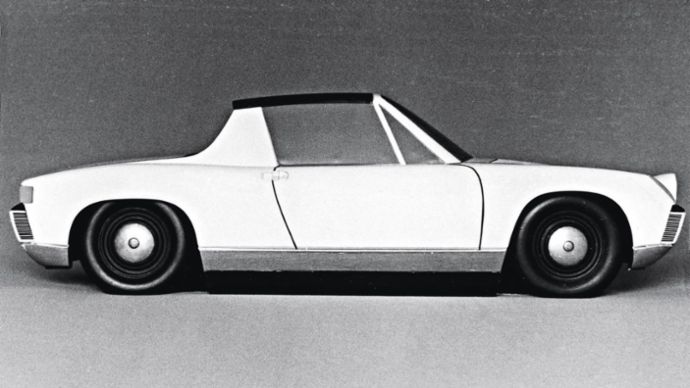
The 914 has an astonishingly good cd value of 0.37. Even with the headlights popped up, and with no complex computer simulations. Does today’s technology limit human design influence?
Despite all the simulation and modern technologies, I believe our creativity isn’t limited. Just like things were in the 1960s. The lads in those days did of course have a basic understanding of things like what works well aerodynamically and what doesn’t. Today, we know that having indentations in front of the wheels and strong indentations at the back is the worst thing when it comes to the aerodynamics. If you look at the brutally straight layout of the 914, it’s the answer to the search for an extremely modern shape. In that case, it’s likely that the aerodynamics worked quite wonderfully from the aspiration to make a very modern car. Surely the result was no coincidence – there were enough people at the company who knew right from the outset exactly what works and what doesn’t. And without today’s simulation methods, too.
In the old days, engineers were designers as well. How many technicians does a designer have to be today?
You have to have a basic understanding. If you want to achieve certain things, you can’t do that without a basic knowledge of what you’re doing. Because without that, we wouldn’t be able to argue against the classic technicians if there was any doubt.
What are your own personal thoughts on the shape of the 914?
I still find the car whimsical, but the picture changes as you look at it more closely. I haven’t really been intensively involved with the 914 to date. From what we’ve been saying over the past hour and the fact that I was aware when it came into being, I’ve come back to the point where I think the car was modern.
“The brutally straight layout of the 914 is the answer to the search for an extremely modern shape.” Michael Mauer
It’s impressive to see how the car stands out in its era. It wasn’t even on my radar before. The car has almost no layout, this middle bit is extremely consistent. To have the courage to design something like this, so big but without a swage line, without fashioning everything – that’s really fantastic. I think the tail is really good. The process up to that point is fascinating from today’s point of view, too. I must confess, I’m still a bit reluctant when it comes to this car, but for me the performance of the time outweighs everything. Coming up with something like that. And there’s the detailed solutions, too: the wide headlights are superb. Or the door handles, minimalistically integrated. Completely new for Porsche. I find it fascinating how F. A. and his team managed to bring in this modern, reduced style, in a similar way to the transition from the 356 to the 911. The more I work with the 914 – that’s exactly what I’m fighting for now. This reduced, puristic approach. Integrating things, not one line too many.
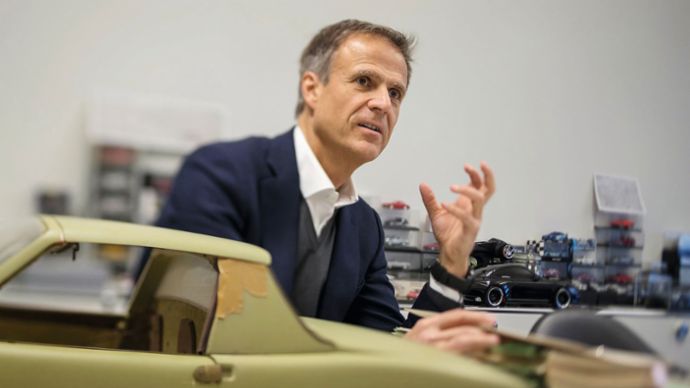
Is there a future for the 914? Or does it at least provide inspiration?
We have this discussion all the time. It’s all about the entry-level Porsche. I think it’s very interesting, but opinions differ on the characteristics of a vehicle like that. Porsche is probably the only brand that could allow this in an unusual way. An entry-level Porsche not in terms of the price, but the sense of reduction. A car with almost no electrics, everything mechanical, puristic. I find the idea exciting. The other one is a car for a target group of people who drive Audi TT RSs or Golf R32s. A Porsche that stands out offering what would have to express exactly that, in formal terms – a very simple, unpretentious car. A modern 550 in the broadest sense. Limits in terms of dimensions are reached quickly, simply because of driving safety. This automatically requires cars to be a certain size. Sales might see things differently anyway. From this standpoint, a much cheaper entry-level Porsche would be the right thing to do – but that’s not my approach. Puristic, reduced, “back to our roots”. I think the time has come. That would be typically Porsche again.
Info
Text first published in the magazine „Porsche Klassik 15“.
The entire interview is published in the Delius-Klasing book “50 Jahre Porsche 914” [50 Years of the Porsche 914] – now in stores!
Interview: Frank Jung
Photos: Deniz Calagan
Copyright: The image and sound published here is copyright by Dr. Ing. h.c. F. Porsche AG, Germany or other individuals. It is not to be reproduced wholly or in part without prior written permission of Dr. Ing. h.c. F. Porsche AG. Please contact newsroom@porsche.com for further information.

